07/03/19
K-State Current - July 3, 2019
K-State Current is a weekly news update for the Kansas Board of Regents to apprise the Regents on a few of the many successes and achievements made by K-State faculty, staff and students.
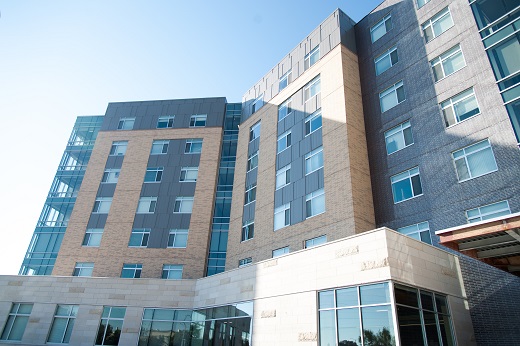
K-State News
DHS, USDA sign NBAF transfer agreement
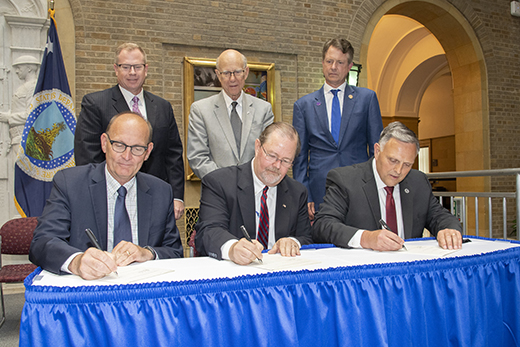 Officials with the U.S. Department of Agriculture and the U.S. Department of Homeland Security sign a memorandum of agreement that will establish responsibilities for the transfer of ownership and operations of the National Bio and Agro-defense Facility being built adjacent to Kansas State University. Looking on in the back row, from left, are Peter Dorhout, vice president for research at K-State; Sen. Pat Roberts of Kansas; and Rep. Roger Marshall, also of Kansas.
Officials with the U.S. Department of Agriculture and the U.S. Department of Homeland Security sign a memorandum of agreement that will establish responsibilities for the transfer of ownership and operations of the National Bio and Agro-defense Facility being built adjacent to Kansas State University. Looking on in the back row, from left, are Peter Dorhout, vice president for research at K-State; Sen. Pat Roberts of Kansas; and Rep. Roger Marshall, also of Kansas.
Officials from the U.S. Department of Agriculture and the U.S. Department of Homeland Security signed a memorandum of agreement on June 20 that formally outlines how the departments will transfer ownership and operational responsibility for the National Bio and Agro-defense Facility, or NBAF, from the Science and Technology Directorate of DHS to the USDA.
According to the USDA, DHS will retain responsibility for completing construction and commissioning of the $1.25 billion facility being built in Manhattan adjacent to the Kansas State University campus, while USDA will assume responsibility for all operational planning and eventual operation of the facility. DHS efforts are on schedule and on budget to complete construction in December 2020 and to complete commissioning in May 2021, when ownership of NBAF will be formally transferred to USDA.
"NBAF will be the first facility in the United States with maximum biocontainment, BSL-4 labs, where we can develop vaccines and diagnostics for high-consequence animal diseases — including those that can also affect human health," said Greg Ibach, USDA undersecretary for marketing and regulatory programs. "These expanded capabilities will enable us to be more dynamic and flexible in responding to disease threats — wherever they come from, whatever they look like."
Peter Dorhout, vice president for research at Kansas State University, said this change in agency leadership is consistent with oversight and management of the type of fundamental and applied research that will take place at NBAF.
"We look forward to partnering with our NBAF and USDA colleagues as we work toward keeping the world and its food supply safe and protecting our food producers and this vital industry, especially here in Kansas," Dorhout said.
According to Ron Trewyn, K-State NBAF liaison, the university's scientists have collaborated with USDA scientists for decades.
"State of Kansas funding has allowed our faculty to jump-start research on four NBAF diseases in the Biosecurity Research Institute at Pat Roberts Hall, and some of that work is being done with USDA researchers from the Center for Grain and Animal Health Research here in Manhattan," Trewyn said. "Future USDA NBAF scientists are being trained in the BRI today. Thus, the interactions should only multiply and flourish in the future."
The state-of-the-art facility will replace the aging Plum Island Animal Disease Center in New York. The Manhattan site is strategically placed near the largest concentration of animal health companies in the world, providing access to important veterinary, agricultural and biosecurity research and expertise.
Doggone it: Fourth of July celebrations not always safe for pets, advises veterinarian
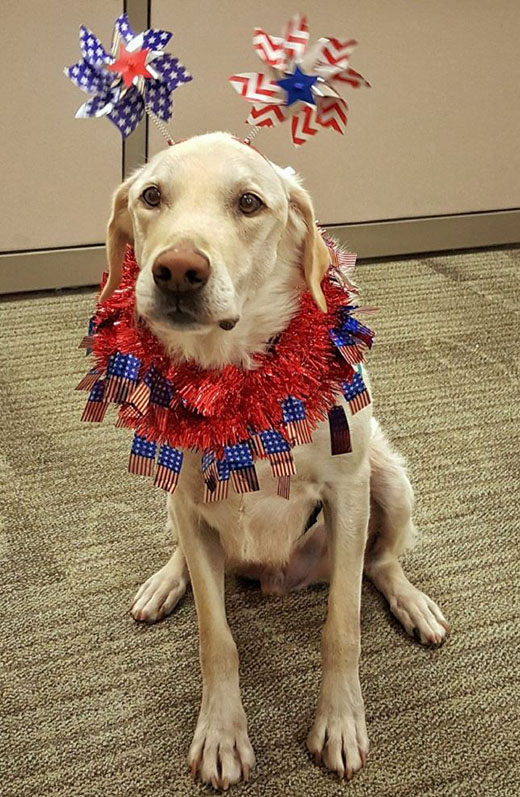 Dude, a therapy service dog, is ready to celebrate the Fourth of July.To make it a fun and happy holiday for all, a Kansas State University veterinarian says keep pet safety in mind.
Dude, a therapy service dog, is ready to celebrate the Fourth of July.To make it a fun and happy holiday for all, a Kansas State University veterinarian says keep pet safety in mind.
The Fourth of July is a time for fun and noisy celebration for many people. But for pets, the summer holiday can be filled with fear and anxiety as well as other dangers, says a Kansas State University veterinarian.
Susan Nelson, clinical professor at the university's Veterinary Health Center in the College of Veterinary Medicine, says the best way to keep your pets safe this July Fourth is by keeping them mainly indoors and then under leash control when they need to go outside.
"The sound of fireworks can make some pets run off in an attempt to get away from the noise," Nelson said. "In fact, this is the time of year with the highest incidence of runaway pets."
Besides getting lost, there is also the risk of getting hit by a car, as a pet's fear will make it less observant of oncoming traffic, Nelson said. She recommends making sure your pet has some type of ID, such as a tag and/or microchip, in case it should get lost.
If you are going to a large fireworks display to celebrate the holiday, Nelson said keep your pet at home.
"Large firework displays, which come with noise and crowds of people, can cause many pets to become anxious," she said. "And leaving pets locked in the car is not an option as warm temperatures can lead to heat exhaustion or heat stroke."
Just being inside may not be enough for some pets who get anxious or fearful because of loud noises and flashes of light. Nelson recommends putting the pet in a secure room where blinds or heavy curtains can block out light.
"Many dogs will appreciate being in the safe confines of their crate and will do fine if allowed to stay there," she said.
Nelson also recommends playing soothing music or turning on the TV or white noise machine to help block out the loud crackles and booms of fireworks. Other options to help pets with mild anxiety stay calm are using an anxiety wrap, temporarily relocating your pet to the quieter home of a friend or relative, or taking the pet to a kennel during the holiday.
Some over-the-counter medications, such as Anxiety TFLN, may benefit pets with mild to moderate noise anxiety.
"If your pet has severe noise phobias, talk to your vet about prescription anti-anxiety medication and have it ready to give to the pet on the first day fireworks are allowed," Nelson said.
The loud noises and bright lights fireworks produce aren't the only things about them that can be dangerous to pets. Nelson said some fireworks, whether lit or unlit, can be toxic to animals. Also hazardous to pets can be items used to ignite fireworks: lighters, punks, matches, lighter fluid, etc.
"Even if your dog is not bothered by fireworks, it could be burned or injured if it gets too close to the fireworks or attempts to retrieve one which has been ignited," Nelson said.
Some products people use to make watching fireworks more comfortable — citronella candles and oils, insect coils and repellants, and even the glow-in-the-dark jewelry kids wear — also can be dangerous to pets.
"Keep dangerous items out of your pet’s reach and don’t apply products that aren’t labeled for safe use on pets," Nelson said. "For example, mosquitoes are often out in force this time of year but don’t be tempted to spray your pet with insect repellants that contain DEET as it is toxic for them. Only apply insect repellants that state they are safe to use on pets."
The Fourth of July picnic also can be a risky time for a pet. Nelson said it's important to keep human foods and beverages out of a pet's reach.
"Pets often experience vomiting and/or diarrhea when given foods they are not used to eating," she said. "And some foods, such as chocolate, macadamia nuts, onions, grapes/raisins, coffee, salt and yeast-based bread dough, are potentially toxic for your pet."
Alcoholic beverages are always a no-no for your pet, so keep the beer and wine out of reach, Nelson said. Other dangerous items that a pet shouldn't get include fatty foods, which can lead to life-threatening pancreatitis; corncobs, bones and wooden barbecue skewers can cause blockage of the intestinal tract if swallowed; and candies sweetened with artificial sweeteners, such as xylitol, can be toxic.
K-State Faculty Highlights
Federal grant to establish Rural Railroad Safety Center at Kansas State University
 The U.S. Department of Transportation's Federal Railroad Administration has announced the recipients of more than $326 million in grant funds under the Consolidated Rail Infrastructure and Safety Improvements Program and the Special Transportation Circumstances Program, for a wide variety of state and local railroad infrastructure projects.
The U.S. Department of Transportation's Federal Railroad Administration has announced the recipients of more than $326 million in grant funds under the Consolidated Rail Infrastructure and Safety Improvements Program and the Special Transportation Circumstances Program, for a wide variety of state and local railroad infrastructure projects.
The grants will fund 45 projects in 29 states, including just over $2.5 million for a Rural Railroad Safety Center at Kansas State University.
"These investments in intercity passenger and freight rail will benefit surrounding communities, make grade crossings safer and improve service reliability," said U.S. Transportation Secretary Elaine L. Chao.
Heading up the project will be Eric Fitzsimmons, assistant professor of civil engineering in the Carl R. Ice College of Engineering. His collaborators are civil engineering faculty members Robert Peterman, professor; and Christopher Jones and Stacey Kulesza, associate professors.
"Our state's economy depends on safe, reliable rail transportation to connect farmers and businesses to the nation and deliver goods to market," said U.S. Sen. Jerry Moran, Kansas. "This grant to establish the Rural Railroad Safety Center at K-State will help solidify Kansas as a leader in rail transportation and share the expertise of officials at K-State with the rest of the country and industry. I was pleased to support efforts to help secure this funding from the Department of Transportation, and look forward to working alongside the university to build and grow this innovative program."
Partner institutions include the University of Nebraska, Lincoln; University of Florida; Pennsylvania State University, Altoona; and California State University, Chico.
"I often brag that the two things American agriculture does is produce more per acre and get our goods to market cheaper and more reliably than any other country in the world,” said U.S. Rep. Dr. Roger Marshall, also from Kansas. "Rail transportation is an important component of this, and I’m proud of the work done to support workforce development and ensure future rail industry safety research through the establishment of the Rural Railroad Safety Center at Kansas State University."
The Rural Railroad Safety Center will have four strategic goals:
• Conduct and promote railroad safety research selected by industry partners and the Federal Railroad Administration.
• Develop a comprehensive unified railroad education curriculum to be delivered at all partnering universities.
• Facilitate novel rail-focused outreach activities, including a bimonthly railroad seminar and undergraduate summer research experiences.
• Disseminate research results and technology transfer to be used by the railroad industry via various outlets.
"I certainly want to thank the entire Kansas Congressional delegation for their support and assistance in securing this grant," Fitzsimmons said.
"By the end of the three-year grant period, it is our goal to have evolved into a vibrant center for industry-relevant railroad research," he said. "Additional educational and outreach programs will be in place to train and develop a diverse workforce for the railroad industry and our research outcomes will help ensure the future of the rail industry is as safe and efficient as possible."
K-State Student News
K-State team wins national crops and precision agriculture contests at NACTA event
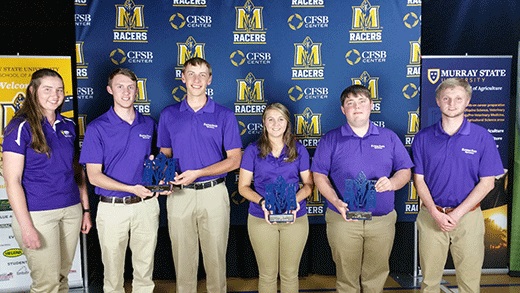 The Kansas State University Crops Team earned top awards at the North American Colleges and Teachers of Agriculture Judging Conference held recently at Murray State University in Murray, Kentucky. Six students participated in three events, placing first in both the crops contest and precision agriculture contest, and second in the knowledge bowl.
The Kansas State University Crops Team earned top awards at the North American Colleges and Teachers of Agriculture Judging Conference held recently at Murray State University in Murray, Kentucky. Six students participated in three events, placing first in both the crops contest and precision agriculture contest, and second in the knowledge bowl.
In the NACTA crops contest, the K-State team placed first over Iowa State University, with the University of Nebraska taking third place. A total of 25 crops teams competed, 15 in the four-year division and 10 in the two-year division. This was the 13th win in the past 21 years for K-State at the national NACTA crops contest, but their first since 2014.
Individually, Nate Dick, junior in agronomy from Inman, took first place overall, and Kaylin Fink, senior in agronomy from Chapman, placed third. Jayden Meyer, agricultural economics major from Smith Center, placed eighth and Luke Ryan, sophomore in agronomy from Solomon, placed tenth. Alternates were agronomy majors Leah Parsons from Leavenworth and Wes Jennings from Abilene.
The crops contest consists of four divisions: laboratory practical, agronomic exam, math practical, and plant and seed identification. At the national contest, the team placed first in math and identification and second in exam and lab. Individually, Nate Dick was first in all four components. Other top five scores were Kaylin Fink who placed second in identification, third in exam and fifth in lab. Luke Ryan placed fourth in identification and Jayden Meyer was fifth in math.
In the precision agriculture event, the team placed first overall ahead of Illinois State University, with Panhandle State University coming in third. Sixteen competed, eight in the four-year division. Individually, each team member competed in one of four contest components. Jayden Meyer was first place in harvesting technology, Nate Dick placed first in planting technology, Luke Ryan finished second in UAVs/drones, and Wes Jennings was fourth in spraying technology.
In the Knowledge Bowl, the team went undefeated through the winner’s bracket, but dropped two matches to Iowa State University in the finals. Leah Parsons was team captain. Other team members were Jayden Meyer, Nate Dick, Kaylin Fink, and Luke Ryan.
The NACTA Judging Conference event ended the spring competition season for the K-State Crops Team. Earlier in the season, the team placed first at both the NACTA Regional Crops Contest in March hosted by the Nebraska College of Technical Agriculture in Curtis, Nebraska, and the Southern Plains Invitational Crops Contest in February hosted by Hutchinson Community College. Additional students competing at Hutchinson were agronomy seniors Daphne Lofing from Osawatomie and Trent Haverkamp from Wamego.
Fifteen students were involved in practices to earn a spot on the K-State team this spring. Kevin Donnelly, professor of agronomy, served as coach for the team. Assistant coaches were agronomy graduate students Chris Weber, Marshall Hay, and Keren Duerksen.
K-State veterinary student selected for National Livestock companies scholarship
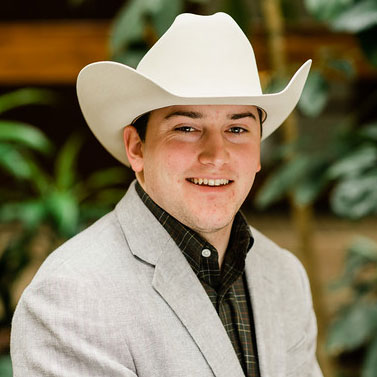 Braxton Butler, third-year veterinary student, Virgil, has been awarded a $5,000 scholarship from the National Livestock Companies consisting of National Livestock Credit Corporation and National Livestock Commission Association. The award was presented to Butler at the National Livestock Annual Meetings in Oklahoma City in March.
Braxton Butler, third-year veterinary student, Virgil, has been awarded a $5,000 scholarship from the National Livestock Companies consisting of National Livestock Credit Corporation and National Livestock Commission Association. The award was presented to Butler at the National Livestock Annual Meetings in Oklahoma City in March.
Overall, National Livestock presented two veterinary medicine scholarships and 22 undergraduate agriculture scholarships, totaling $54,000, to deserving current college students and/or high school seniors.
"I am very honored to have received this scholarship from National Livestock," Butler said. "After school I plan on locating to a rural practice where I can work alongside National Livestock and their clients in a relationship that will hopefully benefit both local producers and the beef industry as a whole."
To be eligible for the annual scholarships, students must be attending or planning to attend an accredited university pursuing a degree program in agriculture or an agriculture-related program. Students must also be a family member of a customer of the National Livestock Companies or be recommended by a customer of the National Livestock Companies. A minimum grade point average of 2.75 must be maintained.
For more information on the National Livestock Companies Scholarship Program, visit its website.